To celebrate B Corp month this year, we spoke to three B Corp communications experts to get their tips on how best to communicate values and impact in the sustainability and ESG space in 2025.
- Rosalind Holley is Director of Communications & Marketing at B Lab UK
- Alessandra Sabellico, Global Corporate Communications & Reputation Director at Davines Group
- Kristen Fuller is Marketing and Communications Manager at Toast Brewing
TL:DR
- The changing face of ESG communications
- Sustainability legislation and compliance
- Engaging with cynical, overwhelmed audiences
- Make it relevant, tangible and easy to understand
- Show the how and build community
- Get comfortable with being uncomfortable
The changing face of ESG communications
We’ve come a long way since the days when sticking the word “green” in front of a product name was enough to convince people that buying it was good for the environment. Today the sustainability agenda has a hard won – if tenuous – seat in many boardrooms and governments the world over, as we face the realities of climate change and social injustice.
Few have observed this journey more closely than those tasked with communicating sustainability efforts and impact. Over the last 15 years, Rosalind Holley has worked for brands including UnLtd and JustGiving, and is now Director of Communications & Marketing at B Lab UK. When she started her career, the sustainability space was very different to what it is today.
“In the early days, people considered that you could either be a charity with a social mission or you could be a big bad business making a profit – it was challenging to get across the message that you could be a business and make a positive impact,” she says.
“Today it’s easier to be a business that considers people and the planet – there are a lot more of them, they’re better known. And increasingly people want to hear what brands are doing in this space, so there’s more of an open door for brands to talk about the work they’re doing.
“At the same time, the explosion of businesses trying to communicate impact means that it’s hard sometimes for people to understand what is true, what can be trusted, which does make it more difficult for brands in that space.”
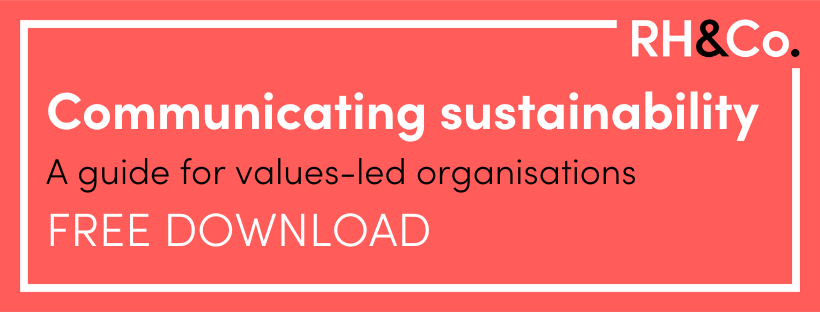
Alessandra Sabellico, Global Corporate Communications & Reputation Director at Davines Group, has been in communications management for over 20 years. She has also seen enormous changes over that time, and believes that the role of sustainability communications is being redefined.
“The role of the sustainability communicator today is to help companies engage stakeholders by telling the whole story of sustainability,” she says.
“This means talking about the difficulties, setbacks and failures on the path to becoming a better company. This is very different from the traditional mindset of corporate communications and marketing, which has been until now to spin the story to make the company look as favourable as possible.”
Sustainability legislation and compliance
Part of what is driving the need for greater transparency within sustainability and ESG comms is the increase in legislation.
“With a series of new regulations coming from Europe (and in the United States as well), the stakes of communicating sustainability are becoming higher and higher,” says Alessandra.
“Greenwashing, in addition to being a huge risk to a company’s reputation, comes with steep fines and threats of legal action, and effective sustainability communicators must learn to balance compliance with a compelling narrative.”
At Davines, this is driving greater teamwork between communications, marketing, sustainability and legal teams.
“This teamwork allows us to figure out what are the things that we can talk about, what are the ones that we’re not ready to talk about and then what do we need to do to change the substance of our sustainability program so that we can make the claims that engage our stakeholders while telling a truthful story of progress.”
Engaging with cynical, overwhelmed audiences
Of course, legislators are only one of the many stakeholders that ESG communications professionals need to consider. And each audience type needs something different.
“The starting point for any communications strategy is who are your audiences, and why are you trying to communicate this with them?” says Ros.
“You might have a specific focus of trying to attract future employees, or you might be more focused on your customers or your communities or other stakeholders like investors, or policy makers.
“If you’re really clear on which of those audiences you’re going after, you can then think about whether you need to tell a story on your product or on your website or through social media. There’s not a one size fits all method. People will want different levels of depth.”
At Davines, engagement means communicating with everyone, starting with employees and ending with clients.
“That’s why internal communication and communication aimed at our community of hairdressers and estheticians is increasingly crucial for us,” says Alessandra.
“This is because those who work in the Group, those who choose its products and those who buy them are not just earning a salary or buying an effective product but are part of a larger project that affects us all and is aimed at generating well-being and value for the planet and for people.”
The challenge for engagement though, is that people are becoming ever more cynical with the increase in sustainability messaging, making it harder to cut through the noise. And it may be that your ESG credentials aren’t the thing they care about the most anyway.
Kristen Fuller, Marketing and Communications Manager at Toast Brewing, says that in the first instance, you have to remember that you’re a business that is trying to sell a product or a service that people need.
“People want to know that we make great beer,” she says. “We’d love to believe that people think about sustainability first but we’re all human, people want a product that tastes great or that works or whatever the reason is that they’re buying something. They want it to deliver on whatever it’s supposed to deliver on.
“What we’ve learned is that you’ve got to convince people in the first instance that the beer tastes great and then they’re open to hearing the impact message.”
Make it relevant, tangible and easy to understand
So what else can communications leads with a sustainability message do to engage their audiences without falling foul of regulations and drawing accusations of greenwashing. At Toast, the answer lies in combining factual data with storytelling, to make impact both tangible and relevant to their audience.
“The thing that our sales teams often focus on is the fact that every pint saves one slice of bread from being wasted,” says Kristen. “So when someone’s drinking their pint, they can think, ‘Great, I’ve saved a slice of bread’ – it’s a small but tangible win.”
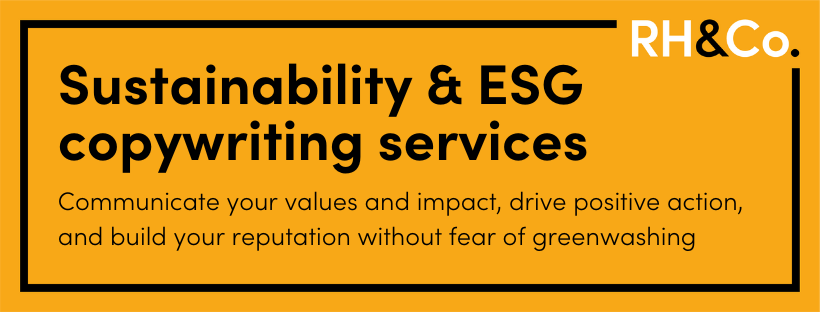
In a similar vein, the team recently dug into the relative carbon footprints of drinking a pint of Toast beer on draft, from a bottle or from a can. They shared the results using a simple graphic on their social channels, which clearly showed how draft had the least negative environmental impact and bottles had the most. The post had exceptional engagement.
“That’s the kind of comms where people went, ‘Wow, great, when I’m buying my beer, I can choose a can over a bottle now and I know I’m making a good choice.” Again, it’s something tangible and that really got people engaged. It’s about making things easy for people to understand.”
B Lab UK’s Ros agrees that simple, straightforward communication that people can understand is key.
“It’s really easy to blind people with science – and it can be tempting to do that to prove the impact we’re having – but if it’s hard for people to understand, it’s not meaningful, then that can start to slide into greenwashing,” says Ros.
“Try to get specific about what you’re doing without resorting to too much jargon, try to make your language human, try to show what it really means in practice, and acknowledge that you’re on a path rather than finished. Because it’s not like you’re ever done with sustainability so don’t try and say that you’re done. Telling the story of the journey as well as the destination is really important.”
Show the how and build community
One of the easiest ways to help people understand your sustainability journey is to let them experience it for themselves. That means sharing it consistently, giving them behind-the-scenes glimpses that show rather than tell them about the work you’re doing.
“It’s the snippets, like Pizza Pilgrims sharing an Instagram reel of where their ingredients are locally sourced from, or Riverford giving over their newsletters to talking about the seasonal impact of their work,” says Ros.
“They allow people to get under the hood of what they’re doing. And that consistent, honest ‘working out loud’ is something people respond really well to because they can see that it’s not about using a superlative once every three years and then never talking about it again. It’s about making it part of the ongoing drum beat of how we tell the story of our business.”
But sustainability comms doesn’t start and end with showcasing your own impact. There are many other ways to engage your audience in the wider conversation, to educate people and encourage them to make better choices.
The Toast team recently got involved with the No Mow May campaign, led by PlantlIfe, encouraging their audience on social media to share pictures of their unmowed lawns and linking it to product giveaways.
“At Toast we believe that food is nature and if we waste food, we waste nature, so getting involved in No Mow May felt authentic to the brand and the people behind it,” says Kristen. “It got a lot of really positive engagement and user generated content.
“It’s about building that community and encouraging people that we can make a difference if we work together. You’ve got to try to get people to engage with the message and spread it, but also not guilt trip them.”
Get comfortable with being uncomfortable
Sustainability communications is an exciting place to be right now, but there’s no doubt it has its challenges. And it’s likely that this space is only going to get more complex as we move ever closer to 2030 and beyond.
We’ll almost certainly see more businesses entering the arena with sustainability messaging, legislation and regulation will shift and tighten, audiences will grow more knowledgeable and demands on us will increase.
In the face of this, it would be easy to shy away from communicating sustainability and impact at all, retreating into ‘greenhushing’ rather than risk being called out for falling short. But that’s not the way to make progress.
“If you’re the spokesperson or the person leading on a sustainability initiative or issue, you have to be willing to engage with it,” says Ros. “It’s a two-way street. If you’re putting communications out into the world, you can expect your stakeholders to have an opinion on them.
“But don’t immediately feel like, ‘Oh no, we’ve been criticised so that’s it, no more communicating about our sustainability efforts!’ Those opinions might actually be constructive, they may give you some interesting pointers as to where you want to go next. As communications professionals, we have to keep the conversation going.”
Getting results from content marketing has never been more challenging. Especially if you’re an ESG-focused organisation, dealing with increasing regulation and cynicism in the face of so much green-washing and values-washing.
Yet with the right strategy, content is still an incredibly powerful marketing tool, especially when it comes to building trust. So how do you ensure that the content you create makes an impact – and showcases yours?
It’s important to understand the challenges that exist within today’s marketing and business landscape, so that you can create a content strategy that takes these challenges into account. Only by doing so can you fully plan to create a brand that stands on genuine value as well as values, and outlasts whatever trend springs up next.
TL:DR
- The content marketing challenge
- The ESG / purpose marketing challenge
- Positioning on value rather than values
- Making sure ESG is an operational effort first
- Being helpful, not just good
- Treading carefully when it comes to AI
- Investing in the longterm
The content marketing challenge
Ever since the phrase content marketing was coined in 2001 there are two issues that have been growing exponentially: noise and cynicism.
In the early 2000s, only the biggest brands had websites. But when WordPress and Squarespace launched in 2003, websites became accessible to all. Then YouTube, Twitter, print-on-demand and all the other platforms and channels arrived and suddenly, the internet was a very noisy place.
As content marketing has evolved, so has our cynicism. We’re far less ready to believe what we read or see or hear than we once were.
And AI is only making these problems worse. From low quality ChatGPT blog content to generic AI-generated responses on LinkedIn and a host of deep fakes across pretty much every digital channel going, it’s no wonder we don’t know who to trust.
If you want lots of content, AI can help. If you want to build a reputation, you still need humans.
The ESG / purpose marketing challenge
Alongside these broader content marketing challenges, there are a unique set of hurdles facing any organisation that has a set of values, principles or ESG-criteria at its heart.
The first is the language used to describe such brands, which is constantly evolving and never simple. As we entered the 21st century, terms like ‘ethical’, ‘green’, and ‘eco-friendly’ were popular. Today we’re more likely to talk about a business being purpose-driven or values-led. CSR (corporate social responsibility) has been joined and in some cases replaced by ESG. None of these really captures the whole truth – and all have been misused.
Then there’s the fact that purpose is no longer a differentiator in the way it once was. As buyers demand more in the way of values from their suppliers, brands are jumping on the purpose bandwagon. Which means that once again, we’re seeing an increase in noise that makes it harder to stand out.
Likewise, people are becoming more cynical. Claim impact without being able to back that up and you’ll face accusations of green-washing or values-washing. Increasingly, you may also face regulatory compliance issues too.
In the face of these challenges, there are a number of factors to consider within your brand and content marketing strategy…

Positioning on value rather than values
First things first – are your ESG credentials really strong enough to be the foundation on which you build your outward facing brand? Are you a Patagonia, a Who Gives A Crap, or a Davines?
If not, you will need to consider how else to format your value proposition, focusing on the value you can add rather than simply the values you hold. Given the choice between a company with a great product and undefined values, or a company with a solid ESG policy but an average product, most buyers would opt for the former.
If you do have the credentials to build a brand around ESG criteria (and your audience cares about this sufficiently for it to be a differentiator), make sure you can back up your claims. In this, as in all things, you need to show rather than tell – and not in a tokenistic way. Pictures of your team planting trees might look great on LinkedIn but if you’re also using non-recyclable plastics in your product packaging, that’s marketing fluff at best and greenwashing at worst.
Making sure ESG is an operational effort first
Speaking of tokenistic, if ESG efforts are led by the marketing department, they are always going to feel like a layer of makeup – designed to embellish or to hide rather than tell the truth. ESG needs to be operationally driven, informing activity and decision-making throughout the organisation, with impact being tracked as anything else would be.
The job of the marketing department in regards to impact is the same as it is in all things – to provide customers and potential customers with the information they’re looking for. People want to know what brands stand for. They want to understand how they treat people and the planet.
So marketers within ESG-focused organisations need to package up that information and communicate it with the outside world as best as possible. To demonstrate impact across all marketing channels, to ensure that impact reports are engaging as well as accurate, to spread the message as widely as possible.

Being helpful, not just good
That said, it’s not just about communicating impact. Wherever you sit on the scale of values, whether it’s a central part of your value proposition or not, remember that your marketing needs to be more about helping your audience than proving how good you are.
As a B Corporation, values are naturally a central part of who we are at RH&Co. And they definitely resonate with our clients, especially fellow B Corps and those in ESG-focused or third sector organisations. But what they really care about is that we’re an exceptional bunch of writers and strategists who can help them communicate their expertise effectively.
Yes, we have an impact report and yes, we sometimes share our views about topics like immigration. But the majority of our marketing focuses on content strategy, getting the best out of subject matter experts or creating content for each stage of the customer journey. In other words, how our creative team helps clients to build their brand reputation.
Naturally, our values are what drives our business – but being helpful and valuable is what drives our content.
Treading carefully when it comes to AI
It would be remiss of us to talk about ESG and content marketing without a nod to AI. It’s arguably the single biggest consideration in the business world right now, and we can no longer sit on the fence over the issue.
The temptation to use AI is strong. It promises an awful lot, and there’s a fear of being left behind unless we adopt it wholeheartedly. But like all silver bullets, there’s more to the story than there might appear.
Regardless of how useful you find tools like ChatGPT or Midjourney or the many in-brand applications springing up, the reality is that there are enormous ethical and environmental costs to using AI. These range from energy and water usage to plagiarism and copyright issues.
And the truth is that, as it stands, it’s simply not good enough to create content that will stand out and have impact in the noise and cynicism that define today’s marketing arena. If you want lots of content, AI can help. If you want to build a reputation, you still need humans.
Investing in the longterm
To truly have an impact in this world, we need to balance short term results with long term impact. Carrying out activities today that have little positive effect on tomorrow just isn’t enough. It’s the ‘feed a person / teach a person to fish’ principle.
We need to take the same approach to building ESG-focused brands. Short term activations may be necessary but if you want to be seen as a values-led organisation then, as well as actually being a genuinely values-led organisation, you need to look at brand building as a longterm exercise.
A lot of the content you create won’t generate exciting results this week or this month or maybe even this quarter. But over time it will all build together to create something much bigger than itself. The somewhat nebulous, often fragile and utterly essential asset every ESG-focused organisation needs: a trusted reputation.
Here’s a scary thought for you: we’re a quarter of the way through the 21st century. It’s been 25 years since we were partying like it was 1999 and paying consultants to protect us against the Millennium bug aka Y2K (if you’re too young to know what that is, Google it for a laugh).
So much has changed since 2000. Which begs the question – how will 2050 compare to 2025?
- What will marketing look like? What new technologies will be shaping the way we work, the way we purchase, the way we consume content?
- What will business look like? What regulations will be in place? What practices will have become utterly unfathomable, like smoking at your desk?
- What will the world look like? Will we have managed to avert the climate crisis? Will we be in the middle of another world war? Which parts of the planet will still be habitable?
Within this context, it’s more important than ever to approach our content strategies… well, strategically. With an eye on futureproofing so that what we create today is still relevant tomorrow. With a solid foundation of research, insight and understanding that will steer us through the rough seas of change we can only guess at.
Having been in the brand copywriting and content marketing game for a good chunk of the last 25 years, here’s what we recommend…
TL:DR
- Focus on what doesn’t change
- Focus on what makes you unique
- Make sure you’re joining up your efforts
- Finally, treat silver bullets with the skepticism they deserve
Focus on what doesn’t change
Trends come and go. Channels rise and fall. But people? They don’t really change all that much. Not at a fundamental level. That’s why human psychology and behavioural science are so enormously important within marketing (just ask Rory Sutherland).
Here are some important truths about people that we should bear in mind when creating a content strategy…
We want to take the path of least resistance
If we’re honest with ourselves, none of us want to work harder than we really have to. Especially at stuff we’re not all that fussed about at a personal level, like which consultancy firm or SaaS platform to use, or how to reduce employee churn or prevent a cyber security attack.
So as content marketers, we need to make buying decisions really, really easy. Use content to help your audience understand the challenges they’re facing. Be as concise as possible and cut the hyperbole (they’ll see through it anyway). Be where they are. Serve them content in whatever way they want to consume it: video, audio, visual, written. Make it easier to buy from you than your competitors.
The truth is that content marketing is harder than ever. It’s exponentially more complex than it was 25 years ago, there’s more competition coming from more angles, and change is happening faster than we can hope to keep up with.
We want to know we’re making good choices
We’ve all experienced phenomena like decision-fatigue, analysis paralysis and buyers’ regret. Making choices about how to spend our money (even if it’s a budget we’ve been assigned) is hard! And harder than it used to be because we’ve got so many more choices – and more ways than ever to research them, which is overwhelming.
If you can help your audience understand what a good choice looks like for them, you will go a long way to establishing yourself as a brand they can trust. The trick is… to not use any tricks. Give them clear, unbiased advice about the solutions available and what options might suit them. Demonstrate what makes your offering unique (without exaggerating), and be sure to focus on what’s relevant to them rather than what’s exciting to you.
We want to be treated as people, and with respect
This one is only becoming increasingly important as the world becomes noisier and more cynical. People don’t want to be sold to. They don’t want to be hoodwinked. They don’t want to be treated as sheep.
Consumers – both in B2B and B2C – have become increasingly sophisticated. They’re not satisfied with generic content. They can spot marketing speak a mile off. They know that if they give you their email address, you’re going to try to sell them something.
You’re going to have to work harder to deliver genuine value or they’re going to go and find someone who will. Do not lump them into a ‘target audience’ bucket. Do your research, personalise where you can, and above all, employ empathy.

Focus on what makes you unique
If your content is based solely on information you can Google, anyone can create it. You can still give it your own spin – your own brand personality, if that’s strong and different enough, or maybe you can make the information more engaging or easier to consume. But you’re still leaving yourself open to someone coming along and doing it better.
By far the better option is to focus on what makes your brand unique. The expertise that exists within your teams, the real-life experiences and personal insights. What have you learned that you can share, which no one else can? What anecdotes will bring your content to life? What analogies will make complex thoughts and ideas easier to digest?
Expert is a word that’s thrown about with wild abandon but it takes a lot of time and effort to become a true expert. It also takes a lot of time and effort to use that expertise to build your brand reputation. And to involve subject matter experts in content creation so that it becomes more than a marketing puff piece. (As you can tell, we’ve written a lot about expertise – it’s what we know best.)
Make sure you’re joining up your efforts
This is what puts the strategy into content strategy. We’ve already talked about the importance of your content being excellent. Relevant to your audience. Helpful. Full of unique insights. But unless you’re a publishing house or media platform, creating great content shouldn’t be a goal in and of itself. It needs to link to wider marketing, sales and business goals.
Getting the content right is about what we call Resonance. But there are two other pillars that make up an effective content strategy: Reach and Results.
The Reach pillar is about how you get eyes on your content. Because brilliant marketing content that isn’t read / watched / listened to by anyone (or only by the wrong people) is utterly pointless. The Results pillar is about how you move your audience along the buyer journey. Not all the way from point A to point Z in one go, but gradually through the right stages until they’re ready to buy.
Your 2025 content strategy needs to consider all three pillars if you’re going to successfully achieve your goals for the year and deliver enough return on investment to secure you a content budget for 2026.
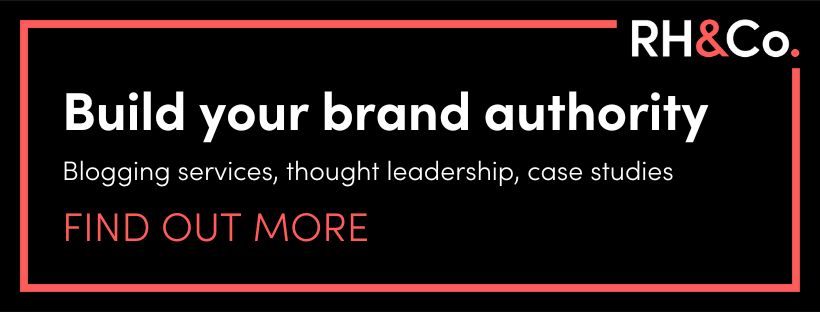
Finally, treat silver bullets with the skepticism they deserve
Since time immemorial, inventors and sales folk have been hailing their creations as the one and only answer to whatever problem it is you might be looking to solve. Nothing has changed. But ChatGPT cannot solve all your content marketing challenges (we know, we tried).
That’s not to say you can’t use new time-saving, effort-saving, or budget-saving tools and techniques as they come along, whether that’s AI or whatever is next. But don’t let them distract you from what matters (deeply strategic thinking, creativity, good old human empathy) or fool you into believing you can shortcut the hard work. If you default to average content, you will fall behind. It’s just too noisy out there.
The truth is that content marketing is harder than ever. It’s exponentially more complex than it was 25 years ago, there’s more competition coming from more angles, and change is happening faster than we can hope to keep up with. Sometimes it’s tempting to give the whole lot up as a bad job and become a yoga teacher or a bus driver.
But if you believe in what you’re marketing then put together a content strategy that does it justice. One that will deliver the results you need in 2025… and beyond.
This article is based on a talk given by Rin at brightonSEO in April 2024. You can watch the recording below.
Sex therapy. Embedded finance. And buying land. At first, these subjects don’t appear to have anything in common. But actually they do – they’re all subjects the RH&Co team have helped our clients rank for on Google.
Is that because our writers are experts in the subject? No – though they know a lot more about them now than they did before! Instead, we leveraged our clients’ subject matter experts and combined their knowledge and insights with our own expertise in communicating complex information in a way that is engaging, valuable and generates results.
Over the last two decades – since the advent of content marketing in the early noughties – expertise has, if anything, become more important. Why? Well, there are many reasons, but this article is about SEO and that means we need to look at EEAT.
TLDR:
- What is EEAT and why does it matter for SEO?
- What is expertise and how does it relate to EEAT?
- How to work with subject matter experts on SEO content
- Beyond EEAT – maximising the ROI of expertise
What is EEAT and why does it matter for SEO?
It was around 10 years ago that Google introduced EAT, very quickly adding another E to form EEAT, which stands for Experience, Expertise, Authoritativeness and Trustworthiness. Here’s how they define these attributes:
- Experience: who are the real people behind the content?
- Expertise: do they know more than the average person?
- Authoritativeness: why should your readers listen to you?
- Trustworthiness: can they trust you?
Strictly speaking EEAT isn’t a ranking factor. However, it is used to guide Google’s Page Quality Raters – the people who assess content and judge how useful it is. These individuals judge individual pages, websites as a whole, and content creators, and they’re looking at literally everything from whether there are SSL certificates to whether the content is actually any good.
This information helps Google to understand whether its algorithms are doing their job. So feedback from Page Quality Raters is likely to have gone into the August 2022 Helpful Content update, which was all about penalising pages that are designed for clicks rather than to inform readers. And the March 2024 Improved Quality Ranking update, which was all about reducing unoriginal content.
Ultimately, Google’s mission is to “organise the world’s information and to make it universally accessible and useful”. That’s what EEAT is about and that’s why it’s important for SEOs. So how do subject matter experts fit in?

What is expertise and how does it relate to EEAT?
We’ve written a lot about what expertise is, why its important and how buyers perceive it. If you really want to dive into the subject, we’d also recommend reading two fantastic books (and giving them to your subject matter experts while you’re at it):
- Expert by Dr Roger Kneebone, which is all about understanding the “path to mastery” ie how one becomes an expert
- The Business of Expertise by David C Baker, which looks at “how entrepreneurial experts convert insight to impact and wealth” ie how to build your authority and reputation as an expert (and make money from it)
For SEO purposes, it’s worth looking at what expertise is as Google would, based on the EEAT definitions in the previous section. In this case, an expert is someone who has real life experience, knows more than the average person, and can demonstrate why we should listen to them and why we should trust them.
Expertise as a positioning strategy
It’s worth stressing that expertise is not a quick fix – it’s a positioning strategy. It takes planning and effort and commitment to get it right and to get results. You can’t simply stick a subject matter expert’s byline on a piece of content and hope that works. Remember, this isn’t about fooling an algorithm, it’s about providing genuine value to your audience and building a reputation over the long term.
Internal vs external experts
Another thing to remember is that expertise exists in many places. Hopefully you will have subject matter experts within your business – your consultants, your CTO, your product leads, even your head chef, if you run a restaurant. Internal experts allow you to own that knowledge, experience, authority and trust as a brand.
But there are external experts that can be worth tapping into as well. These could be your partners, industry influencers, even your own users. Drawing on their knowledge and experience for your content makes you an expert by association.

How to work with subject matter experts on SEO content
So if you’re a marketer tasked with building a reputation for your brand, where do you start with EEAT? How do you actually work with your subject matter experts to create content that works for both your readers and for Google? Broadly speaking, there are three approaches.
Get your experts to create content for you
Advantages:
The advantage of this approach is that it takes less of your time – in theory, at least (see disadvantages). As a result, it’s scalable: lots of experts = lots of content. And it’s pretty low cost because you’re not having to bring in any professionals to create that content for you.
Disadvantages:
Unfortunately, the reality is that coordinating experts whose main role (and skill) is not content creation is a lot like herding cats. Your experts – whether internal or external – are busy people with their own agendas, so content is likely to slip down the ‘to do’ list.
They’re also not marketers. They aren’t trained to look at what an audience will engage with, they don’t understand tone of voice, they’re not used to seamlessly weaving in appropriate keywords. As a result, you could end up with copy that needs so much rewriting you may as well have done it yourself.
How to do it:
If you are going to get experts creating content for you, the first thing you’ll need to do is to sell the benefits of them getting involved, or even incentivise them, especially if they’re external.
You’ll also need to create some sort of editorial guidelines – tone of voice, content length and so on. And you’ll need decent briefs that explain exactly what you want each piece of content to contain, to achieve etc.
And you’ll still need that internal content champion – whether it’s you or someone else – who can do the “cat herding” and can also look after edits and amends to ensure that the content is consistent, that it’s on brief, and that it achieves its objectives.
Create content and get experts to sign it off
Advantages:
At the other end of the scale, this method involves writing the content yourself and simply getting your experts to approve it, which has some very attractive benefits.
First, you have full control of content. You can make sure it’s on brief, on brand, that it ticks the right keyword boxes and so on. You’re also not reliant on anyone, except in the final approval stages, which can be tricky still but not nearly as tricky as getting a busy subject matter expert to write something for you.
Disadvantages:
The downside is that unless you’re also a subject matter expert, any content you create is likely to contain little genuine and unique expertise – things like real life anecdotes or analogies that only someone deeply rooted in the subject would come up with. That means the content will probably be easily replicable. And if you want to increase the volume of content, you’ll need more writing resource.
How to do it:
Despite its limitations, this method of creating EEAT content for SEO purposes can be very effective. It’s how we helped our client Blueheart, a health tech scale up, increase their site visits by 300% within 6 months.
If you do go down this route, you’ll need to develop really good research skills. You’ll need to be able to sift the wheat from the chaff, especially when it comes to credible sources and authoritative citations – no linking to a Wikipedia page as the source of your knowledge.
And ideally, draw on case studies so at least you’ve got some unique brand stories in there, even if you haven’t got personalised insights directly from your experts.
Work collaboratively with your experts
Advantages:
This is how we most often work with our clients – from global consultancies like TPC Leadership to fintech scaleups like Weavr. It allows us to get the best blend of our client’s expertise in whatever it is that they do, and our expertise as content creators.
Speaking directly to subject matter experts not only allows you to get factual insights but the juicy nuggets that make the best content uniquely appealing and valuable – experiences, anecdotes and analogies that bring those facts to life.
Disadvantages:
On the downside, it does take more time. You will need more writing resource, you’ll still need to convince your experts to prioritise time to give you their insights, and it may well be that the approval process is challenging, especially with internal experts.
How to do it:
As with getting them to do it themselves, you’ll need to sell the benefits and potentially incentivise your experts. You’ll also still need to create some sort of ‘prebrief’ so that they’re prepared and bring the right information to the interview process.
Speaking of which, you’ll need to develop your interview skills because, just as not all experts are great content creators, they’re not all great communicators either. Some will give too much detail, some not enough. Some go down rabbit holes and need constant pulling back to the subject at hand.
This is often why our clients call us in – it’s not just because we write well, it’s because we know how to wrangle subject matter experts and get the best out of them.
Beyond EEAT – maximising the ROI of expertise
So we’ve looked at three different ways to involve experts in creating content for SEO and you can see that what we said at the beginning is true – expertise is a positioning strategy. It’s not an easy-fix to all of your SEO problems. The good news is that there are so many added benefits to leveraging subject matter experts beyond SEO, especially if you’re using internal ones.
By helping them to clarify their thinking, you prepare them to do all sorts of things – take part in webinars, speak to the press, give talks at conferences. And you can repurpose that content on social media, in emails, in ABM campaigns.
Whether it’s sex therapy, embedded finance, buying land or any other subject that’s relevant to your brand and your audience, by leveraging subject matter experts you can create not only EEAT-boosting super content but an awful lot more besides.
Is using generative AI ethical? Recently, we wrote an article about how generative AI tools like ChatGPT are increasing two problems that content marketers have been facing ever since that term became popular: noise and cynicism. There’s just so much content out there, we can’t possibly digest it all – and how do we know if we can trust it?
Another place where we’re facing information overload and a lack of clarity around what we can trust is in the subject of generative AI and ethics. Are the evangelists misleading us with their enthusiasm? Or are the naysayers overhyping the dangers? And how should we navigate the advance of these technologies, especially as values-led businesses?
At RH&Co, we’re keeping an open mind when it comes to generative AI. On the one hand, we’ve been experimenting with how useful it can potentially be to us and to our clients. But as a B Corp, we’ve also been looking into the darker side of AI, so that we can build out our own policies in a way that supports the planet and its people.
TL:DR
- A caveat before we start
- Environmental concern: generative AI’s use of electricity and water
- Misinformation: Hallucinations and fake news
- Human rights and ethics: what about the people?
- How should values-led businesses respond to generative AI?
A caveat before we start
First, let’s clarify the language. This article by the Harvard Business Review does a great job of distinguishing between important AI terms such as generative AI, machine learning, natural language process and so on.
It’s important to understand that what we’re talking about in this article is the tools that respond to human prompts by creating content in one form or another. Tools like ChatGPT, Dall-e, Midjourney and so on.
Secondly, we’re not discounting the many ways people are finding tools like these helpful, from helping to overcome dyslexia when writing emails or internal reports, to creating summaries of meetings for quick reference.
Generative AI is changing rapidly, and to discuss the merits of individual tools and their current abilities would make this article redundant almost as soon as we hit publish. Instead, when asking “Is generative AI ethical?”, we want to look at the broader issues that underpin the use of this technology so that we can ensure that, as a user group, we call for a version of AI that doesn’t sit contrary to our values.

Environmental concern: generative AI’s use of electricity and water
Every time we use digital technology, we use energy. Not just the electricity that goes into powering our smart phones and computers, but the energy that goes into sending our emails, storing our documents and connecting our video conferences. As a result, every individual and organisation now has a digital carbon footprint.
Generative AI is adding to this footprint. There’s the energy needed to develop and train the models, not to mention the energy needed to complete a query. While there are no straightforward answers when it comes to how much energy AI uses – as this article by a Boston University computer sciences professor showcases – it’s clearly something we need to consider.
The same goes for water use, as this article in The Independent highlights. One of the studies referred to in the article, by researchers at the University of California and University of Texas, suggests that “training GPT-3 in Microsoft’s state-of-the-art U.S. data centers can directly evaporate 700,000 liters of clean freshwater”, and that “global AI demand may be accountable for 4.2-6.6 billion cubic meters of water withdrawal” by 2027.
This is not to say that we shouldn’t use generative AI. But using it arbitrarily when other options are available feels like an unnecessary way to increase our digital carbon footprint and water use.
Misinformation: Hallucinations and fake news
Lying and misleading people isn’t a new phenomenon – it’s been around as long as the human species has. But it’s easier to mislead today than it’s ever been, and to do so at scale.
This study, published by Cambridge University Press, looks at the role of artificial intelligence in disinformation. In the abstract, the researchers state that AI systems “boost the problem [of disinformation] not only by increasing opportunities to create realistic AI-generated fake content, but also, and essentially, by facilitating the dissemination of disinformation to a targeted audience and at scale by malicious stakeholders.”
In some cases, people are deliberately using generative AI to create fake content, as with the video of Australian businessman Dick Smith supposedly promoting an investment opportunity – or the numerous examples cited in this Sky News article.
But there’s also the challenge of AI ‘hallucinations’, where tools like ChatGPT make up answers rather than admit they don’t know something. Read our article about how AI is increasing noise and cynicism for a prime example involving our very own James Matthews.
Again, although none of this means we should avoid generative AI entirely, it does pose the question of how we regulate it and how transparent we are about using it.
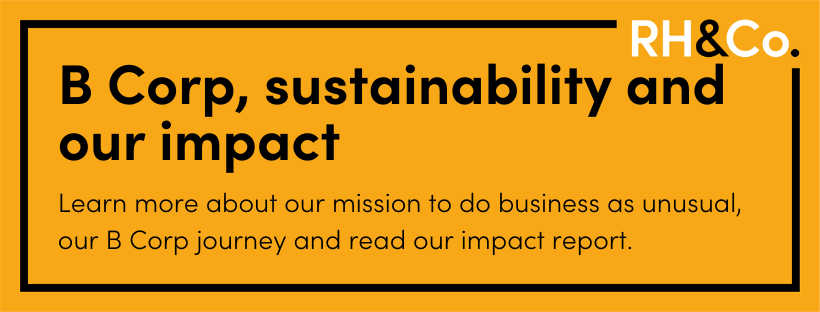
Human rights and ethics: what about the people?
How do you get an AI to decide whether text contains inappropriate or offensive subjects? Easy – just get humans to read the text and tell the AI whether it’s acceptable or not. Except imagine you’re one of those people. What’s that going to do to your mental health?
That’s the issue that faced content moderator Mophat Okinyi when he worked for Open AI (the creators of ChatGPT) in Nairobi, Kenya. The text and images he was required to review depicted a variety of scenes too unpleasant to go into here, leading him to become withdrawn and paranoid, and ultimately resulting in the breakdown of his marriage.
Obviously this is an extreme case but there are other ethical issues that we need to consider when it comes to generative AI. This quote from UNESCO’s Assistant Director-General for Social and Human Sciences, Gabriela Ramos sums up the breadth of the challenge: “AI technology brings major benefits in many areas, but without the ethical guardrails, it risks reproducing real world biases and discrimination, fueling divisions and threatening fundamental human rights and freedoms.”
For those of us in creative industries, a big concern is the way that generative AI is trained on work that human beings have produced and may not have shared reproductive permission for. Is training generative AI the same as an artist being inspired by viewing the works of others, or is it an infringement of copyright?
It’s not a straightforward answer. An article in Harvard Business Review stated that “the legal implications of using generative AI are still unclear, particularly in relation to copyright infringement, ownership of AI-generated works, and unlicensed content in training data.”
How should values-led businesses use generative AI?
So, is using generative AI ethical? We’d love to say that we had a simple answer, particularly as a B Corp that believes in doing business as unusual. Unfortunately, the issues aren’t clear cut, not least because the technology and the regulations surrounding it are changing virtually every day.
So what should we do? Well, we can only say what we at RH&Co are doing, which is staying informed, actively seeking out a variety of viewpoints, experimenting and testing, and keeping an open mind.
Our plan is to draw up an AI policy in time, and when we do we will be sure to share it here on our website. If you have any thoughts, suggestions or resources to share, we would be very happy to receive them.
AI is not going to be the end of the world as we know it but it is going to have an enormous impact on it. Let’s work together to ensure that it is a positive one for our planet and all of its people.
Another post about generative AI and content creation – yawn! Except this one isn’t really about AI at all. It’s about two key challenges that existed long before ChatGPT came on the scene, and which AI is simply going to exacerbate. Challenges that content marketers need to have firmly in their sights if they don’t want to become redundant. Here’s the context…
Ever since ChatGPT launched in November 2022, the debate around using generative AI in content creation has been raging. Some people are all for it, some people are convinced that it’s the end of marketing as we know it, some are sticking their heads in the sand and hoping it all goes away.
At RH&Co, we’ve been experimenting with how it could enhance the work we do for our clients – but we’re also keeping on top of the various environmental and social challenges that it AI presents.
The truth is that whatever argument you might make today will probably be out of date tomorrow, since the technology is changing so fast. There is one thing we can be pretty sure of though, and that is the fact that AI is going to exacerbate two problems content creators already face: noise and cynicism.
TL:DR
- Noise: The rise (and rise) of content marketing
- How AI is adding to the content noise
- Cynicism: who are you to tell me?
- How AI is adding to the cynicism challenge
- How to create content that breaks through the noise and cynicism
Noise: the rise (and rise) of content marketing
In ye olde times (ie the 20th century) content marketing as we know it didn’t really exist. In fact, according to the Content Marketing Institute, the term was first used in 2001. Back then, publishing content was by and large the preserve of media organisations, and only a fraction of businesses even had websites.
Then, in 2003, WordPress and Squarespace launched. Overnight, creating a website became accessible to pretty much anyone. Two years later, YouTube was born, then Twitter the year after that, and content creators had two new platforms through which to share their work.
Since then we’ve seen an explosion of tools and channels with which to produce and distribute content, each one adding to the noise. Today, the amount of content being published on a daily basis is practically unquantifiable. Millions of tweets, blogs, LinkedIn posts, Medium articles, Tiktok videos, Insta reels created and shared every month.

How AI is adding to the content noise
Generative AI tools – from Chat-GPT and Jasper to DALL-E and Runway – are making it easier to produce high volumes of content at speed.
According to Hubspot’s ‘AI trends for marketers 2023’ report, 48% of marketers now use generative AI for creating content. Although 96% go on to edit the copy generated, it saves them an average of 3 hours per piece, meaning they can produce more.
Whether any of it is any good isn’t really the point – bad content existed before AI too. The point is that with everyone able to produce more content, more quickly, there’s more noise, which makes it even harder for marketers to make their brand’s voice heard.
You need people to trust that you know what you’re talking about, otherwise they’ll scroll straight past or click away without hesitation.
Cynicism: who are you to tell me?
A second side effect of the increasing ease with which people have been able to produce and distribute content over the last two and a half decades is the similarly increasing difficulty of policing all that content.
While traditional media has standards to which it has to adhere – at least in theory – those standards don’t exist in nearly the same way when it comes to social media posts, for example. If you want to create a meme and attribute the quote to Albert Einstein, who’s going to ask you to reference your sources?
Just look at the case of Instagram scammer Belle Gibson, who built a personal brand around the fact that she had supposedly “cured herself of cancer” through “clean eating”. Although she was eventually brought to justice, she built up a following of thousands and even launched an app before someone cottoned on to what she was doing.
Likewise, wannabe authors today no longer have to go through the rigours of a formal publishing process – they can simply upload their content to Amazon and use its print-on-demand service. If you want to get a sense of how this has lowered publishing standards, try searching “flat earth book” on Amazon and you’ll see.
In the face of all of this, it’s no wonder that people have stopped asking, “What can you tell me?” and started asking instead, “Who are you to tell me?”

How AI is adding to the cynicism challenge
Thanks to AI, we’ve now gone from a world of fake news to one of deep fakes. Images of public figures doing things they never did – like the video of Australian businessman Dick Smith supposedly promoting an investment opportunity.
There’s an AI Instagram influencer making thousands of pounds a month even though she literally doesn’t exist in real life – and even reportedly getting asked out by celebrities who have no idea she’s not real.
And it’s not just the intentional misinformation that’s an issue. Like many others, we came across an example of AI’s willingness to play fast and loose with truth when our very own James Matthews asked a newly launched ChatGPT to recommend three episodes of his podcast, The Moisture Farm Report.
It selected three – except none of them actually existed. When challenged, rather than admit it couldn’t find any information – the podcast was launched in October 2021 and therefore wasn’t included in the data that iteration of ChatGPT had been trained on – it simply kept inventing new episodes.
Bad sources have always been a problem in content but blatant AI hallucinations are giving people more and more reasons to question what they read online.
How to create content that breaks through the noise and cynicism
Whether you use generative AI to help you in the content creation process isn’t really the issue – it’s how you cut through the noise and the cynicism that counts.
To do this, your content needs to be unique and it needs to be credible. You need to be able to add genuine value and you need people to trust that you know what you’re talking about, otherwise they’ll scroll straight past or click away without hesitation.
One of the best ways you can create content that ticks all of these boxes is to involve subject matter experts in creating content campaigns.
These subject matter experts might be internal – if you work within a consultancy firm then it’s your consultants, for a SaaS platform it might be the CTO or product lead, in a restaurant it’s the chef. Or they could be external – partners, influencers, users.
By harnessing their unique insights and experiences, your content becomes exclusive – something no other brand could produce. And the content becomes a platform on which you can layer other brand building activities, from media opportunities to speaking engagements, sales outreach campaigns and so on.
If you’re interested in learning more, read our guide on how to involve experts in content creation, or get in touch to see how we can support you to create content that cuts through the noise and the cynicism.
Back in the day, positioning yourself as a green / ethical / sustainable (delete as appropriate) bank or fashion brand or consultancy practice was a relatively straightforward thing to do, assuming you could back it up in some way.
These days it’s not so easy. With everything from ESG regulations to the explosion of the B Corp movement, having social and environmental values is no longer a differentiator – there’s just too much noise.
As business advisor and author David C Baker wrote recently about purpose-driven agencies, “There are a thousand firms claiming that space, and thus it has become a distinction without a difference.” He goes on to say that he’s a big proponent of being-purpose driven, but adds, “It’s a good thing, but it is not positioning.”
So should you bring your brand values into your positioning? Can it be done effectively, and if so, how? And are there any alternatives?
TL:DR
- Just because it’s a feature, doesn’t mean it’s a brand
- From values to disruption: defining your cause
- Understand your value beyond your values
- In all things, show don’t tell
Just because it’s a feature, doesn’t mean it’s a brand
There are times when signalling a particular values-led product or feature is worth doing. For instance, a consumer will want to know if the toilet paper you’re selling is recycled or not, so by all means stick that on the packaging. But don’t be fooled into thinking that makes you Who Gives A Crap.
Who Gives A Crap oozes values from every pore. Not only is the product made of sustainable bamboo, they donate 50% of their profits to build toilets and improve sanitation in the developing world. They’re so passionate about their cause that one of their founders sat on a toilet in a warehouse and refused to move until their first £50,000 campaign was crowdfunded.
Crucially, because they were one of the first to really offer toilet paper that feels like a missional purchase, they could market it as exactly that.
However, if you were working at Andrex, and the company switched to using recycled fibres one day, you’d have a hard time convincing people you were the values-first choice. You’d be far better off sticking to your ‘soft as puppies’ message. Your recycled fibres alone would not give you the grounds to lead with a sustainability message.
By all means make ethical choices as a brand. But you only earn the right to build a value proposition around your ethics if they run uninterrupted through your business model.
As an aside: A glance at the Andrex site shows you their mission is “to leave a greener pawprint on our planet” which, while cute, doesn’t exactly ring true when you consider their parent company cut the use of recycled fibre from 29.7 in 2011 to 19.3% in 2021, and Ethical Consumer advised against buying their products in report published in May 2023.
To make this point with a B2B example, if you’re a commercial cleaning company and you use only environmentally friendly products, that’s absolutely something your clients might want to know. But it’s not enough to start marketing yourself as the green alternative.
By all means make ethical choices as a brand. But you only earn the right to build a value proposition around your ethics if they run uninterrupted through your business model. Because in this age of greenwashing, unless your values are near faultless, you’re going to be called out – or at the very least you’ll raise eyebrows from sceptical buyers (who might have given you a chance if you hadn’t embellished a feature and tried to hold it up as a sustainable brand).
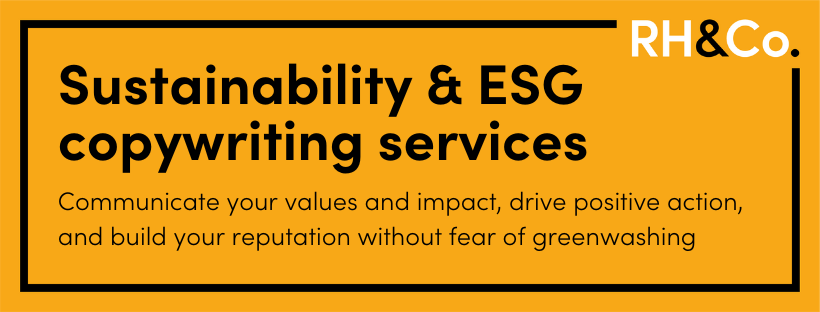
From values to disruption: defining your cause
So let’s imagine you work for a business that can hand-on-heart claim to be values-first. The problem you’re facing now is that too many other businesses are trying to lead with the same message. They’re all using the same language.
Which means your value proposition needs to be built around a specific cause. You can’t just be a ‘people-first fashion brand’ or an ‘ethical HR tech platform’ or a ‘green manufacturer’. Be clear about how you’re disrupting your sector, whether that’s championing size and gender diversity, advocating for skills-based hiring to combat hiring bias, or making a circular economy possible in a given locality.
If you can’t go big with a values-led message, your best bet for cutting through the noise is not to shout but to let others infer what you stand for from your actions.
For instance, Tony’s Chocolonely have built their entire business on “making chocolate 100% exploitation free”, rather than pitching their brand as “the ethical chocolate company”, a phrase that feels shallow by comparison.
Making chocolate 100% exploitation free isn’t just Tony’s brand positioning, it’s their business model. More than 9.2% of their retail price goes to cocoa farmers – more than the Fairtrade premium – and they work directly with farmer cooperatives, ensuring that premiums reach individual farmers.
If your brand is similarly cause-based, it can act a little like disruptive companies in the tech industry. And your marketing can cut through the noise using a couple of disruptive principles:
- Change the rules of engagement, showing people a new idea is true or possible, e.g. ethical clothing can be affordable if we do it at scale (see Yes Friends – “…it costs as little as 10p extra per T-shirt to pay workers a living wage in India, and as little as £1.50 per tee for fairly traded organic cotton”).
- Show empathy before you sell. Assume the consumer or client wants to do the right thing and they’ve simply been working with a broken system until now – they’ve been navigating greenwashing and social-washing, and maybe getting disillusioned too.

If you’re changing the way an industry operates, you can afford to bring your cause into both your value proposition and your communications strategy. You can be like Patagonia and only ever run awareness-campaigns instead of product ads, or you can create reports that urge further change in the industry, or you can hone a message that flips people’s perceptions on their head.
Understand your value beyond your values
So what about the brands that are genuinely doing their bit for People and Planet as well as Profit but can’t quite claim to be disruptive frontrunners? Should you still try and position yourself around your values?
Let’s explore this using a set of three imaginary IT companies. You’re the customer or client trying to pick one.
- Option 01: Beige IT – Good performance, good price
- Option 02: Surprisingly Digital – Good performance, good price
- Option 03: Whatcha Gonna Do Consulting – Good performance, good price. Achieving a positive social impact.
Naturally you’d choose the more impactful business, PLT Consulting. However, we’re rarely in such a clear, clean cut scenario. You’re much more likely to encounter the following set of IT services companies:
- Option 01: Reed IT – Can probably meet your needs.
- Option 02: PLT Consulting – Can probably meet your needs, and the brand showcases a few ways it is green or sustainable or values-led.
If that’s all you’re choosing between, you’ll likely go for option 02. Until we add another company into the mix.
- Option 03: Performance Wave – Can deliver exactly what you’re looking for. They have made no claims about their values, but they seem perfect from a performance angle.
Suddenly PLT Consulting, the business that made a point about advertising their values, isn’t quite so appealing, is it? Those values have been overshadowed by the fact that Performance Wave can deliver exactly what you’re after.
Most of us want to make ethical choices wherever we can. But the truth is – unless a brand offers a disruptively ethical alternative – we’re rarely going to choose a company that appears to be values-based over a company that delivers exactly what we need. That’s true whether we’re talking about toilet paper or cloud infrastructure or legal services.
If your audience is primarily in the market for a HR consultant, you need to focus on how you’ve helped companies bring back their workforces from the brink. That doesn’t mean you shouldn’t talk about your fundraising efforts for your local conservation charity and your commitment to pay the Real Living Wage, but these things need to take a supporting role.
Because ironically, if you can’t go big with a values-led message, your best bet for cutting through the noise is not to shout but to let others infer what you stand for from your actions. Infuse your values throughout your marketing – share pics of your team doing charity work, create an impact report to showcase how you’ve been reducing carbon emissions – but don’t lean on them as central to your value proposition.
In all things, show don’t tell
So should you bring your brand values into your positioning? Only if it really is a central cause around which you’ve built your business, and which you can back up with evidence that even the most cynical aggressor would be hard pressed to deny.
Can values-based positioning be done effectively? Yes, if you go beyond generic terms like ‘sustainable’ and ‘green’, and hone your narrative around a clearly defined cause that runs clearly through your entire business model.
And are there any alternatives? Absolutely. Because we can’t all be Patagonia or Tony’s Chocolonely or Ecolab. But we can and should be infusing our values through all that we do. And, if we follow the ‘show, don’t tell’ rule, that can absolutely include our brand marketing.
For more on how to market your impact, read the first article in our series on sustainability and ESG, which is all about greenwashing vs. greenhushing.
If you want to be taken seriously for your ESG and sustainability commitments or your social impact, sooner or later you’re going to need to pull back the curtain on what you’re achieving.
Enter the impact report. It’s a document that will be familiar to any B Corp, non-profit or company that has grown to the point where it needs to disclose its impact by law.
TL:DR
- Different types of impact report
- Business impact reports vs charity impact reports
- How to create an impact report with impact
- Who do you need to write an impact report
Different types of impact report
There are many types of impact report, addressing different stakeholders and concerns:
- Charity annual reports
- Programme reports
- Environmental impact reports
- Social impact reports
- Health impact reports
- B Corp impact reports
- Modern slavery statements
- Gender pay gap reports
In and of themselves, these reports can have great value for benchmarking and tracking progress in an organisation. That’s not all though. With the right thinking and narrative behind it, these reports can create an impact that’s all their own.
Business impact reports vs. charity impact reports
The fundamental difference between business and charity impact reports is that of stakes.
A non-profit’s impact report is justifying its existence. It needs to say, “Donors, this is why you should keep donating. This is what your partnership has accomplished. Here is the evidence this organisation is making a difference in the world.”
A business impact report, meanwhile, is evidencing its ethics. It’s shining a light on the impact – positive and negative – that the company has on the environment and / or other stakeholders.
For a business, the stakes will rise or fall depending on several factors:
- Positioning of the business. If a company has built its brand around a cause – for instance, slave-free chocolate or carbon-free clothing – it will attract more scrutiny, whether that be from buyers, regulators such as the FCA, or journalists.
- Stakeholders. If a company’s partners, investors, and clients are evaluating their own ESG-credentials, they’ll want to know more about those they do business with. Also, if a company works in or with regions where human rights or conservation violations are high risk, it’s all the more important to be meticulous.
- Industry and growth stage. If you’re a small company in an industry not known for its impact reports, the fact that you’re creating an impact report at all will speak to your audience. If you’re a multinational FMCG, there will be more regulatory and stakeholder pressure to disclose a greater depth of information and take bolder action.
Even if the stakes are low, that’s not to say your impact report can’t have an impact in and of itself. It can be an invitation to employees, partners or other stakeholders to go on the sustainability journey with you, or it can challenge others in your industry to take bolder action. With the right narrative behind it, it can become a key milestone in your organisation’s story.
How to create impact with your report
If you’re primarily creating an impact report because you have to do it, you risk overlooking the value it can bring to your organisation. When it’s firing on all cylinders, an impact report can achieve a whole lot more than compliance. So how do you make sure yours delivers on all fronts?
1) Make sure your impact is instantly clear and evident
Outcomes:
- Deepen trust with stakeholders
- Stand up to scrutiny
In an age of greenwashing and greenhushing, an impact report will stand out if it’s candid and clear. It’s all too easy for an organisation to create an impact report that obscures the important details with vague statements, commitments and a showcase of non-critical action. But a report that is aware of its audience and speaks honestly to what they care about will build a better brand reputation.
If in doubt, focus on the outcomes to your actions rather than the actions themselves. Charities are typically great at this. They know if there is no qualitative or quantitative measure of impact, there is little point in reporting the action. For instance, don’t only say you launched a new D&I committee, show how that committee is already shaping your organisation’s policies and processes.
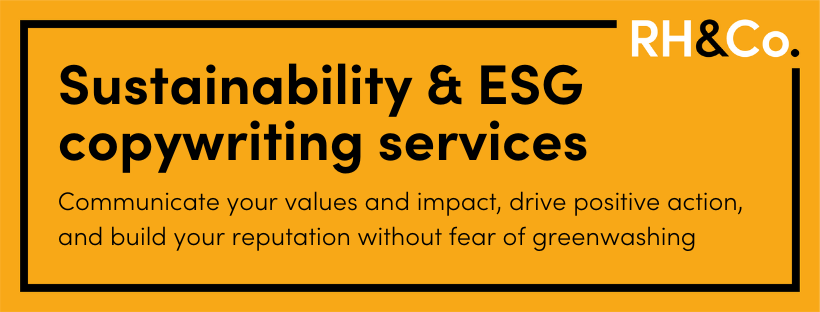
2) Weave smaller stories into a wider narrative
Outcomes:
- Win over the fence sitters
- Give your audience a reason to stay invested
The story you tell through your impact report can also be a swing factor for people looking for reasons to become a donor, stay investing, keep partnering, renew their membership, or continue a client-supplier relationship.
That’s not to say your report should advertise your sustainable brilliance (unless you really can justify it), but you can showcase how your company is learning, facing up to its challenges, and building a future that fence sitters will want to be a part of.
Personal stories are key here. This might involve a case study demonstrating how your partners are working to protect mangrove forests, or interviews with the people impacted by the changes you’ve made to your health programme, or the small business owners your direct trade is supporting. Personal stories will make a statistic like “we supported our NGO partner with 352 pro bono hours” far more meaningful to everyone reading it.
3) Don’t leave it all in the report – spread the message
Outcomes:
- Attract new leads and build your reputation
- Motivate your team, brand advocates, and volunteers
Depending on the content of your report, you may also be able to use its quotes, case studies and statistics in your marketing campaigns. Not everyone will read the full impact report, but if you snip parts of it up into social posts, internal comms, executive summaries, emails and so on, your message can go far further.
If your comms paint a clear picture, your team, brand advocates and volunteers are also more likely to stay loyal to your cause. When they see what they’re contributing to, it can put fresh wind in their sails.
Who do you need to write an effective impact report?
The answer to this question will depend a little on the scale of your operations and the stakes involved. If you’re a sole-trader, for instance, you could technically have a go at creating the whole report yourself.
That said, if the stakes are higher, you’re unsure of where to start, or you want your report to have the greatest impact possible, you might want to make use of the following:
1) Sustainability & ESG consultants
If you’re a scaling company new to the annual report process, you’re not sure which ESG or sustainability framework to use (GRI, TCFD, SBTi, IRIS+, etc.) or you’re aware that your data collection has had too many gaps in the past, it can be helpful to work with a sustainability consultant.
A consultant – or indeed an internal ESG and sustainability expert – can help you to understand what companies, investors and regulators will want to see. They can also facilitate stakeholder workshops to help map out the scope of what you should be reporting on, and how you can collect and present the data in a responsible way.
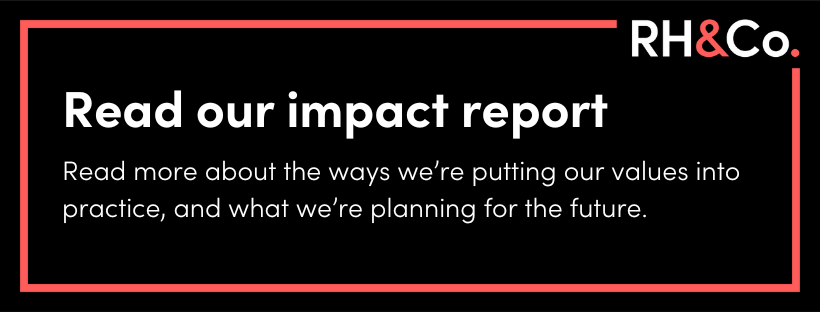
2) Subject matter experts
No organisation can create an effective impact report without contributions from people in charge of key areas. This might involve consulting with the professors in charge of key research, or receiving full case studies written by your technical team. You can also bring in the voices of external experts and partners to provide a broader perspective.
If parts of your impact report are written by subject matter experts, you’ll probably need to edit the tone of voice for the sake of consistency. If your wider audience is non-specialist, you may need to simplify some of the language too, without losing the nuance that specialist readers will expect.
To learn more about how to do this, see our guide to involving experts in content creation.
3) Content strategists and writers
Sustainability and ESG content specialists like RH&Co will ensure your report not only adheres to regulatory and ethical standards but that it also resonates with your audience on an emotional level – both line by line, and as a whole document.
We can help you to answer questions like: What’s the wider story we’re telling as an organisation? How can this impact report build momentum for our brand or cause? How can we launch this report as part of a wider campaign that attracts new members, hires, donors or clients?
In other words, how can we ensure that, when we launch this impact report, it actually makes an impact?
At RH&Co, we’ve helped shape impact reports for global charities and nationwide non-profits like the AHSN Network and Animal Free Research UK, as well as for B Corp businesses like BaseKit. We also launched our very own impact report in 2023. To learn more about how we can support you with your impact report, don’t hesitate to get in touch.
First, let’s be real: the most effective protection against greenwashing is to have an environmentally sustainable business model.
If your organisation is…
- Doing literally nothing to harm the planet
- Only producing a positive impact on the environment
…well, you’re probably in the clear.
Alas, we live in a world where this describes very few companies. We also live in a world where businesses that have a net-bad impact on the environment are frequently popping up in the news for claiming they are “the world’s most sustainable airline” or “at the forefront of sustainable innovation”.
So most businesses are left in a carbon pickle.
TL:DR
- Why we need to market our impact – and how it can go wrong
- Be concrete in your language and claims
- Seek accreditations from independent bodies
- Be transparent about mistakes…
- …and about limitations
Why we need to market our impact – and how it can go wrong
We want to talk about the good things we’re doing because a) it’s good for the brand, b) it can help customers choose brands that align with their values, and c) we need to celebrate positive environmental impact where it exists so that others follow suit.
At the same time, we can’t resort to the standard marketing tactics of hyperbole, positive spin, and selling the future before it arrives. Otherwise we end up advertising “hydrogen-ready” boilers to consumers who don’t know that hydrogen won’t be a viable fuel till at least 2025, and who don’t realise all boilers have effectively been hydrogen-ready since the early 1990s. That’s a faux pax of CMA-clamp-down proportions.
So how can we highlight our positive environmental impact without losing face or falling off a regulatory cliff in the process? As some in the industry are starting to say, how do we navigate the space between greenwashing (embellishing claims) and “greenhushing” (no concrete claims at all). Greenhushing, depending on who you ask, is either brand shyness or another, even trickier, form of greenwashing.
Tearing your hair out yet? Let’s protect your scalp by exploring how you can market your environmental impact effectively.
1) Be concrete in your language and claims
To begin with, you can throw out any urge to describe your products using the terms eco-friendly or natural. To be honest, in this age, it’s arguable whether you should even use the word sustainable. After all, Patagonia, the most recognisable fashion brand for this sort of thing, doesn’t use the word sustainable to describe any of their products. Instead, they opt for concrete terms:
- 100% recycled polyester shell and lining
- Made with durable organic hemp
- Utilises fabric scraps and recycled bottles to reduce our reliance on virgin raw materials
And so on. There are times when it’s helpful to use the word “green” or “sustainable” to describe a product if it’s measurably more green than alternatives, and that’s its primary differentiator. But you’d better be able to back it up to the hilt with concrete reasons why it’s green (biodegradable, plant-based, made in a solar-powered factory, made of 100% recycled materials etc.). If your list of reasons is damage-control at best, steer clear. After all, plastic is recyclable and we don’t call that green.

2) Seek accreditations from independent bodies
There are plenty of pitfalls when it comes to self-disclosure and company commitments. For instance, what do the following statements have in common:
- We aim to reach net-zero carbon emissions across our operations by 2040
- Our product range uses recycled materials like polyester as we work towards transitioning to better materials.
Any guesses? Well… they’re both misleading. Really, really, really misleading.
The first statement was made by Amazon in an attempt to position the company as a climate leader. Turns out, according to a private report, the retail giant isn’t counting emissions associated with any third party products on their site – only Amazon branded products. That means when they’re talking about hitting zero-carbon, they’re only counting the carbon for 1% of their online sales.
The second statement is found in Boohoo’s Ready for the Future range. Nice name. But a CMA investigation is underway, since the actual amount of recycled materials included in a new garment might be as low as 20%.
And it’s not an isolated problem either. In 2020, an EU’s assessment of 150 product claims found that 53% used “vague, misleading or unfounded information”. Is it any wonder why consumers are growing cynical?
So what’s the antidote, other than being very vigilant about what you do and don’t claim? For many, accreditation from external bodies are the answer.
One of our clients, Davines Group, uses the platform Provenance to evidence the brand’s claims about its haircare products. Provenance uses blockchain data to fact-check claims about social and environmental impact against the company’s supply chain. So if they say a product has “widely recyclable packaging” or “supports biodiversity”, there’s an independent voice to back it up. The Davines brand itself is also a certified B Corp – so they have another independent voice on their side.
3a) Be transparent about mistakes…
“Be authentic” is an easy thing to say but it’s hard for many brands and businesses to pull off. For a start, most would rather only be candid if their honesty will be met with applause – the equivalent of a pop star wearing their heart on their sleeve. Authenticity that involves, say, how unsustainable your current practices are, well, that’s less sexy.
That’s why greenwashing exists, after all. It’s so much easier for a corporation to showcase the 1% of the organisation that’s conducting research into a net-zero transition than it is to be upfront about the 99% that’s contributing to a climate or ecological crisis.
However, if you are chasing a genuinely sustainable future, and not trying to keep an environmentally toxic business afloat, brutal honesty can help put your impact in perspective.
When eyewear brand Ace & Tate became a B Corp in 2021, they could have announced it with green fanfare. Instead they announced it with the words Look, we f*cked up. Our bad moves, and proceeded to list all the ways in which the company had failed at sustainability, and what they were doing about it.
Within this they were clear to explain the limits of their carbon-reduction: “We can say we’re Carbon Neutral, but we still have a long way to go on the journey towards becoming net-zero.” They also showcased concrete errors: “We chose to produce a glasses case from Polyphenylene Ether (PPE) and bamboo fibre. It turns out, that’s not as sustainable as we thought.”
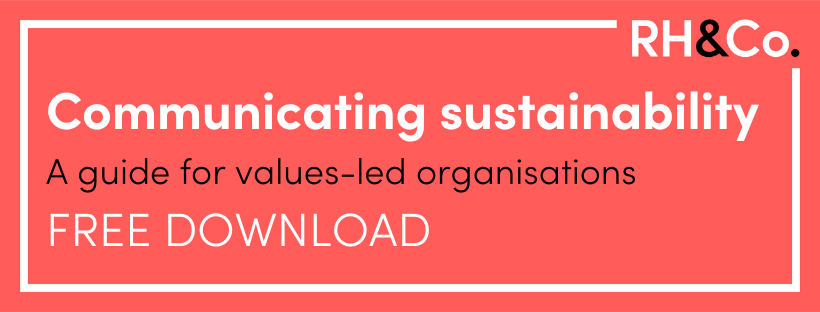
3b) …and about limitations
Even if you’re an engineering firm that only works with wind farms contracts, there are going to be limits to your positive environmental impact (possibly even a few downsides as well). And all companies can win more trust by sharing a little more than they do.
One of our own clients in HR consultancy was careful to do this in the promotion of a different kind of pension. We wrote an article for the company that had words to the effect of: For decades, our company recommended pensions that damaged the earth. Now we’re trying to change that. And yes in the interim, we’re partnering with companies that are offsetting rather than 100% carbon neutral. It’s not perfect but it’s a step in the right direction.
You might disagree with this brand stance on offsetting but at least you’re able to tell what the company is doing vs. what it isn’t. Whether or not they’re making the right move, at least they’re upfront about what they’re doing. And while transparency won’t endear a brand to everyone, it’s better than talking vaguely about being carbon neutral in a gambit for universal appeal.
Technology is defined as the application of scientific knowledge for practical purposes. And in some fields, all those aspects are constantly on the move – the knowledge, the application of it, and the purpose behind it.
You might be in an emerging field like generative AI, an established industry like martech that’s constantly competing for the next edge, or a reactive industry like cybersecurity that’s constantly evolving to meet the next threat. Either way, you’ll probably be selling the future, commenting on what’s next, and trying to keep up with everything that changed yesterday.
It’s a challenge to market in such fast-moving industries. How do you present a consistent brand when you need to constantly evolve? How much do you say about your product roadmap when it’s always shifting? And how do you convince the world you’re still one step ahead of your competitors?
TL:DR
- Challenge 01: The industry is changing
- Challenge 02: Your products are changing
- Challenge 03: Your customers are changing
Challenge 01: The industry is changing
You wake up, and suddenly aluminium-sulphur batteries exist. New neural-implants are viable. And, although plenty of companies haven’t finished the build of their last closed loop payment system, open loop solutions are everywhere.
Many of the technology industries move as a kaleidoscope moves. It’s part of what makes these sectors so interesting to work in, and it’s also what makes life so challenging for marketers.
As Deloitte wrote in their 2023 Tech Trends report: “Before the economic landscape of the metaverse changes from fluid to concrete, pioneers will need to make their moves.” That is just as applicable to the fields of XR, embedded finance or haptics as it is for the metaverse – both on a business level and a brand level.
It’s not always about changing your product pipeline today. Sometimes it’s enough to show you’re aware you might need to change it tomorrow. If you’re a mathematical forecasting company, for instance, your brand content might need to address quantum computing. Or if you’re in open payments, you might need to be talking about future government regulation and how your SaaS platform will be ready for it.
The danger is that in an attempt to seem ahead of the curve, technology companies can overreach. Everyone wants to talk about the next big thing so they can catch the attention of those scanning the horizon. But you’ll want to stay within the boundaries of your expertise, otherwise customers with a better understanding of the emerging technology will see through you.
Solution: Talk to your subject matter experts
This is an area where siloed marketers are a bad idea (though to be honest, are siloed marketers ever a good idea?). Marketers are often the ones with their finger on the pulse but they rarely understand the circulatory system of veins and arteries beneath that pulse.
If marketers can work with the experts in their company, and extract their perspective on an emerging subject, they’re much more likely to talk to an audience with the right level of depth, nuance and cautious optimism. In our experience, data scientists, CTOs, and product leads are also more aware of when they shouldn’t comment on a topic at all.
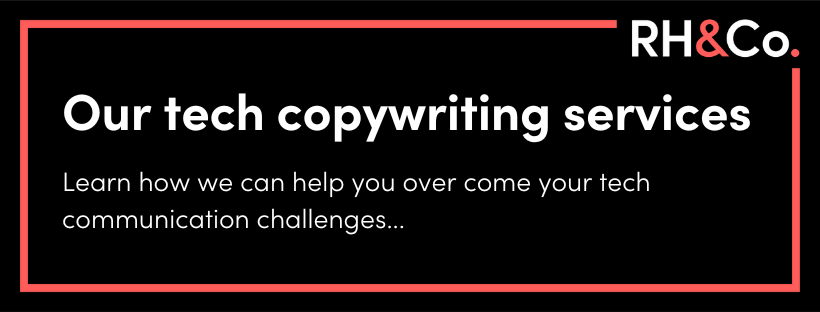
Challenge 02: Your products are changing
You’re used to selling a journey to a destination you haven’t finished laying the rail tracks to. The build might not be locked in, there’s still end-to-end testing to be done, but you have to market what you’re building next – because everyone else is too, and you need to show that you’re ahead.
Of course, this status quo comes with its fair share of high profile vapourware products. Whether it’s Google Stadia simply promoting features they were never able to release, or the extreme 80’s case of Ovation’s office suite programme, which was advertised with a fake demo to try and gain the funding the product team finally needed to finish it (they never did).
Overpromising isn’t an option, but neither is under promising. For a number of our clients it’s a constant balancing act: knowing when to say a feature is ‘coming soon’, using the future-facing words investors want to hear (did somebody say blockchain?), and holding fire when a feature just isn’t ready to be talked about.
Solution: Sell the future but don’t speculate
Marketers here need to keep two hands on two pulses – your audience’s needs, and your product team’s ongoing struggle to build, test and fix according to schedule.
There’s one senior product marketer we work with who is particularly skilled at doing this. As a result they’re very adept at knowing the nuances of when, how and at what frequency to advertise a feature or benefit. At times, we’ve seen them put the hard brake on the company’s content or advertising, and there have been occasions where they’ve suggested winding down the selling of a product altogether.
In our conversations, it’s been important for us to listen to their input but it’s been equally important not to hit delete on a claim unless we had to. Often it’s been a matter of suggesting alternatives and tweaks that position the messaging exactly where it needs to be. That way the brand could still sell the essence of what they’re building towards without slipping into speculation.

Challenge 03: Your customers are changing
Tech is affected more by trends than almost any other industry, with perhaps the exception of fashion. The difference is that in the fashion industry, at least historically, people make impulse, almost-instant purchases. Whereas in the technology industries, product purchases can take months, or even years to complete.
This means that the B2B technology you’re selling when you complete a sale is never exactly the same product as when you first pitched. You need to catch your addressable market’s attention now but you need to anticipate what their wants and needs will be next year. Or possibly the year after, if you’re selling to an enterprise.
A different but related issue: your audience might shift entirely. 73% of technology startups pivot to a different market over time, and even if you stay the course in a single sector, almost inevitably the size and maturity of organisations you’ll be targeting will increase.
Sometimes this change needs to happen suddenly for tactical reasons. One brand we work with has recently switched from just targeting new challenger companies, to targeting long established organisations in the energy market, based purely on new activity of these companies’ sales reps.
Solution: Keep evolving your brand intentionally
Recently, in preparation for a brand voice and messaging workshop with a scaleup, we combed through several documents that detailed the company’s customer personas and brand strategy. Even though they were created in the last 9 months, we were told they were already out of date.
No brand can remain static, and in fast-moving technology industries, you’ve got to be even quicker on your toes. As we explored in our roundtable discussion on how much should brand evolve, your messaging needs to hit the sweet spot between brand consistency and brand relevance. And to do this, you need to be constantly revising your customer personas and reevaluating your brand strategy to match.
Sometimes this is about crafting vertical-specific messaging that speaks directly to the up-to-the-minute ambitions of specific target markets. But you’ll also want to step back occasionally to reevaluate your overall brand and content strategy to make sure it’s going to resonate with your audience as a whole.
The trick is to be intentional. We’ve seen fast-moving technology companies evolve their brands unintentionally – which is a natural outcome of hiring, scaling and trying to swim in bigger ponds.
Maybe the company starts using the same tech-normative language as their new peers, or possibly their values fade into the background as they focus on selling their technology’s bottom line benefits. At this point they often need intentional brand engineering.
In case you missed it, check out the first blog in our series on marketing challenges in the technology industry: Clear as nanocrystal: How to market complex technology.

